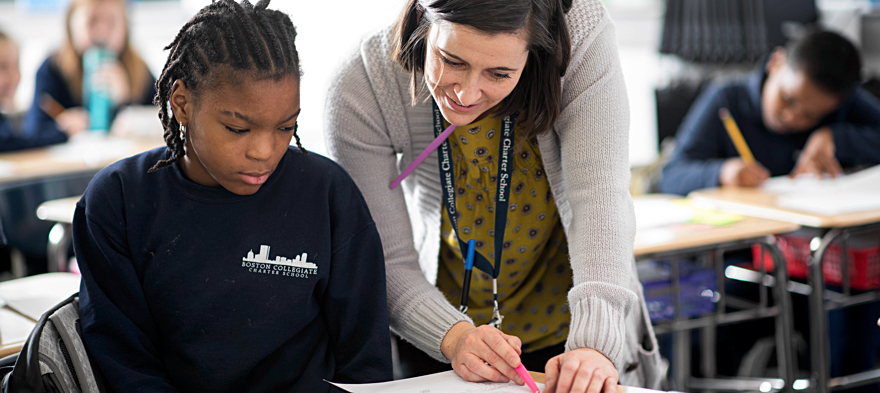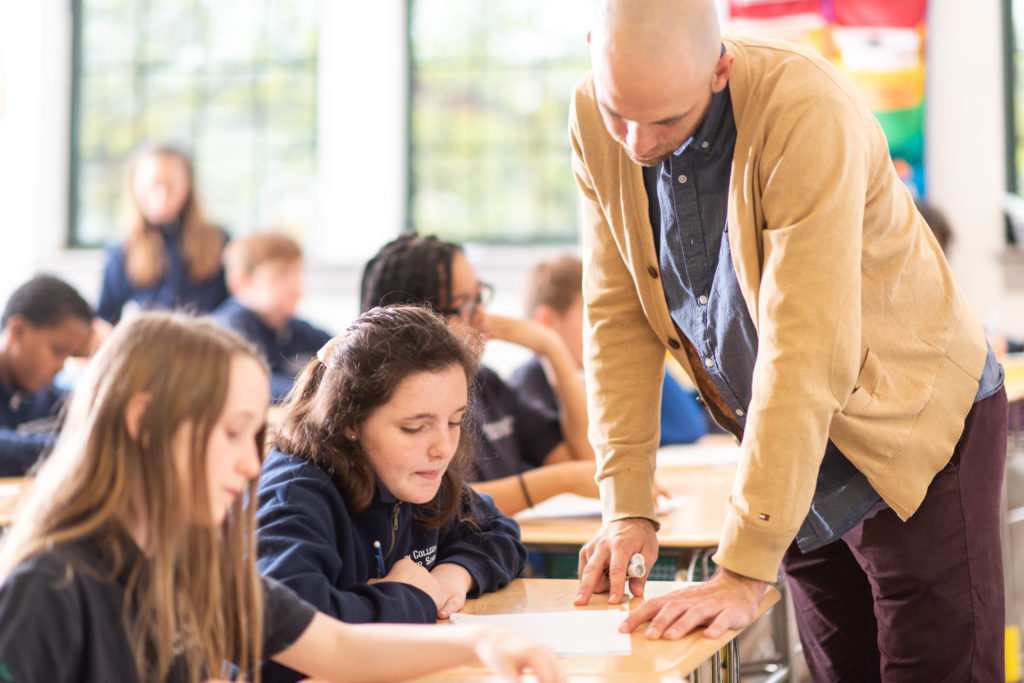
It was early March 2020 at Boston Collegiate Charter School in Boston, Massachusetts. We—two seasoned public school educators—were getting ready to wrap up our second year of co-teaching. Despite having 25 years of combined teaching experience, the start of our co-teaching time had been filled with that familiar first-year-of-teaching anxiety.
Anyone who has experienced or observed co-teaching understands it is not easy for two people with different experiences, styles, and work habits to effectively co-lead a classroom. In fact, the presence of two adults in one classroom does not magically improve a student’s experience or guarantee academic growth for that class. It takes trial, error and a whole lot more to figure out how to be effective co-teachers. Although there were some guidelines and strategies available on this practice, when we started on this journey [pullquote]we understood that there was no perfect template for co-teaching—we would have to figure out what would work best for us.[/pullquote]
As such, as we were approaching the two year mark in late winter 2020, we’d decided to pause, reflect, and write down what we’d learned about co-managing a classroom and the impact it had had on our kids’ learning in the hopes that these lessons might offer some food for thought for other educators looking to try out co-teaching in their classrooms. In our time co-teaching, we had come to deeply believe in the power of this model to help ease teacher stress and workload, which we believe is essential as our country continues to work on ways to improve teacher recruitment and retention.
Little did we know that in a few weeks' time, we’d not only experience the biggest challenge of our professional and personal lives, but we’d also learn that what we thought we knew about co-teaching and its benefits— both in-person and virtually—would only be the tip of the iceberg.

First, regardless of whether we’re in person or virtual, our vision for co-teaching is simple: We both lead the class.If you were to ask our students who their lead teacher is, they would not know how to respond. This is not always the case when it comes to co-teaching. From our observations and experience, co-teaching usually involves a lead teacher and a support teacher. The lead teacher is typically responsible for grades and lessons while the support teacher assists. At the start of our co-teaching, we decided our roles would be interchangeable—we would equally share the center stage and provide support to students.
This also means that [pullquote]we don’t divide up the classroom—all of our students are both of our kids.[/pullquote] The students we teach have diverse backgrounds and abilities—approximately 30% of our students are students with disabilities. Having two adults fully invested in the classroom allows us to build more meaningful relationships, know our students as learners, and work towards their individual needs. When we were 100% virtual this fall, the person who created the lesson plan would “present” and the other teacher would provide support, scaffolds and motivation. The teacher who was not presenting would verbalize questions or misconceptions that were coming up in the lesson. Once we started to have more students learning in person, one of us would virtually present the lesson for all students, both at home and at school, and the other person would be in person, providing additional support, examples, and challenges to the students learning from the building. The fact that we have always been true co-teachers made this transition as smooth as possible with our students.
Second, we share the daily grind, in-person and virtually. We both plan lessons, create and copy materials, and grade student work. One of us plans three or four lessons in a row that cover a specific concept. That teacher engages in all materials creation and delivers the content. The benefit of having one teacher own the full planning of a concept allows for continuity and guarantees scaffolding. The teacher not creating the current lessons is focused on planning future lessons and tracking student data. Not only does this system allow us to balance our time, but also it holds us accountable to make quality lessons for each other.
Even though lesson responsibilities are divided, lessons are not created in complete isolation. We spend our shared planning time reviewing lesson plans and materials, ensuring they will reach all students. The planning structure guarantees all lessons are created with purpose and, importantly, keeps our workload sustainable.
In the virtual world, one of us pushed the other to keep lessons focused and succinct. The other nudged when it came to making sure we remembered to focus on concepts. We also became increasingly comfortable improving lessons on the fly (“Hey, this didn't work, why don't we try this instead…”). It became clear pretty quickly that we could not take things personally if one of our finely honed lessons bombed with the kids. Importantly, we maintained trust that the other would create well-designed lessons in a timely manner. [pullquote]Being able to rely on one another became even more important during our time with remote learning.[/pullquote]
Third, we always set the tone together. Managing a classroom in middle school is not easy, but sharing a mindset around how the class should operate, and supporting high behavior and academic expectations keeps everybody sane. While one of us leads the lesson, the other constantly circulates, clarifies instructions or redirects behaviors in a way that does not distract the rest of the class. Our expectations are clear, it is easy to remain united—we are always on the same page in front of our students.
Moreover, we model those same expectations with one another. When one of us makes a mistake in front of the class, we are comfortable (and at times enjoy) calling each other out—“Oops, Ms. Adam, you missed the appropriate units on your final answer!” Not only are we okay with this, but it also signals to our students that feedback and mistakes are a part of learning.
[pullquote position="right"]Our strong rapport in the classroom has been built by always staying mindful of one another's needs throughout the day.[/pullquote] The way we function helps eliminate the “invisible stress” of being in front of a room of students day in and day out. When we moved to fully online instruction, we had to gain a new intuition about each other. We still set the tone, but shifted to leveraging hand signals, thumbs up, and speed up signs. We also had to be comfortable with interrupting each other: “Excuse me, Mr. Ellis? There is a great question in the chat that I'd like to highlight.”
Our strong co-teaching foundation and practices have continued to not only make us better teachers, but they have also decreased our day-to-day strain in what has been an extraordinarily difficult time for educators across the country. As we emerge from this year of crisis, teacher retention and recruitment will continue to be a national issue, and finding ways to make the profession more sustainable is urgently necessary.
A solid co-teaching relationship has helped us ease daily pressures, divide the workload and made the classroom experience even more enjoyable. [pullquote]We believe that an investment in co-teaching, in the long run, is an investment in teacher sustainability and student learning and growth.[/pullquote] As we get ready to close out our third full year of co-teaching (now in-person and in a virtual classroom), we no longer feel that first-year-teaching anxiety; instead we find ourselves brimming with enthusiasm, to continuously become better teachers.
Bridget Adam joined Boston Collegiate Charter School (BCCS) in 2003 after completing her education at the University of Wisconsin-Madison. She was a 2015 Massachusetts Teacher of the Year finalist and currently serves as the sixth grade Mathematics teacher. She also holds a position on the BCCS Board of Trustees.
If you have a child with disabilities, you’re not alone: According to the latest data, over 7 million American schoolchildren — 14% of all students ages 3-21 — are classified as eligible for special...
The fight for educational equity has never been just about schools. The real North Star for this work is providing opportunities for each child to thrive into adulthood. This means that our advocacy...
The story you tell yourself about your own math ability tends to become true. This isn’t some Oprah aphorism about attracting what you want from the universe. Well, I guess it kind of is, but...
Your donations support the voices who challenge decision makers to provide the learning opportunities all children need to thrive.
Ed Post is the flagship website platform of brightbeam, a 501(c3) network of education activists and influencers demanding a better education and a brighter future for every child.
© 2020–2024 brightbeam. All rights reserved.